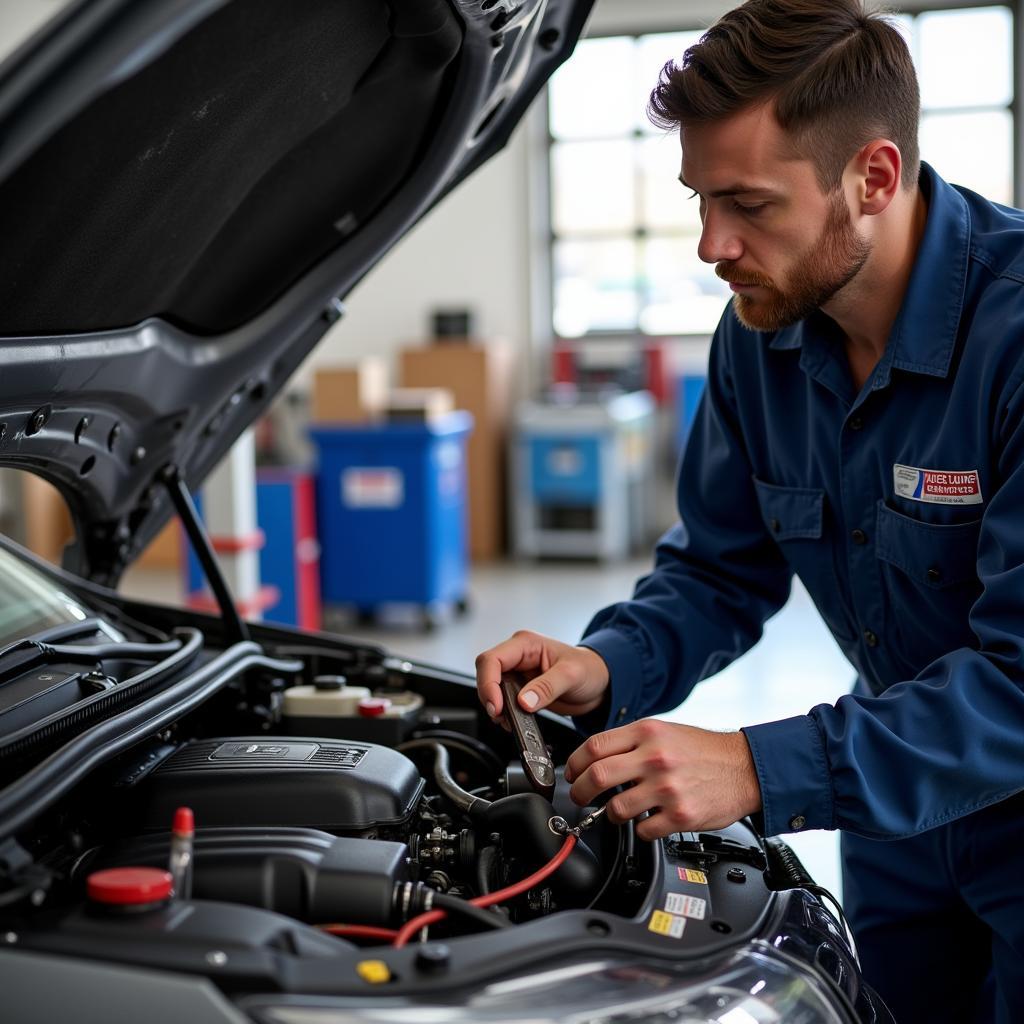Car Bumper Fixing Gum offers a quick and seemingly easy solution for minor bumper repairs. But is it the right choice for your situation? This comprehensive guide will delve into the world of car bumper fixing gum, exploring its uses, limitations, and proper application techniques. We’ll also cover alternative repair methods and help you make informed decisions about fixing your car bumper.
Understanding Car Bumper Fixing Gum
Car bumper fixing gum, also known as bumper repair adhesive or plastic weld epoxy, is a two-part adhesive specifically designed for repairing plastic bumpers. It’s marketed as a DIY solution for cracks, small dents, and even reattaching broken pieces. The gum typically consists of a resin and a hardener that, when mixed, create a strong bond. However, it’s crucial to understand that this fix isn’t a miracle cure for all bumper woes.
While car bumper fixing gum can be a cost-effective solution for minor damage, its effectiveness depends heavily on the type and extent of the damage. For instance, it works best on clean breaks and cracks, but might not be suitable for large dents or heavily damaged areas. Additionally, the long-term durability of the repair can be affected by environmental factors such as temperature and exposure to UV rays.
When to Use (and Not Use) Car Bumper Fixing Gum
Car bumper fixing gum is a great option for small, clean breaks and cracks in plastic bumpers. Imagine a scenario where you’ve backed into a pole and created a hairline crack. That’s a perfect candidate for car bumper fixing gum. Similarly, if a small piece of your bumper has broken off cleanly, the adhesive can often reattach it securely.
However, avoid using car bumper fixing gum on large dents, heavily damaged areas, or bumpers that are structurally compromised. In these cases, the adhesive simply won’t provide enough strength or stability for a lasting repair. You might think you’re saving money, but a weak repair could lead to further damage down the road. For significant damage, consult a professional for car body fix recommendations.
How to Apply Car Bumper Fixing Gum Like a Pro
Applying car bumper fixing gum effectively requires proper preparation and technique. First, clean the damaged area thoroughly with soap and water, removing any dirt, grease, or wax. Then, roughen the surface around the damage with sandpaper to create better adhesion. Next, mix the resin and hardener according to the manufacturer’s instructions. Apply the mixture to the damaged area, ensuring complete coverage and a smooth finish. Allow the gum to cure completely before sanding and painting.
What if you don’t prep the surface properly? Well, the adhesive won’t bond correctly, and your repair will likely fail. It’s like trying to build a house on a shaky foundation—it’s just not going to work.
Exploring Alternative Bumper Repair Methods
While car bumper fixing gum is a viable option for some repairs, it’s not the only solution. Depending on the extent of the damage, other repair methods might be more appropriate. These include plastic welding, bumper replacement, and traditional body filler repairs.
For example, plastic welding provides a stronger and more permanent fix for larger cracks and broken pieces. This method uses heat to melt the plastic together, creating a seamless repair. On the other hand, bumper replacement is the best option for severely damaged bumpers that are beyond repair.
“For extensive damage, replacement often becomes the most cost-effective solution in the long run,” says automotive expert, Michael Stevens, from Autotippro. “While it might seem expensive upfront, it prevents recurring issues and ensures the structural integrity of your vehicle.”
Making the Right Choice for Your Bumper Repair
Choosing the right repair method depends on several factors, including the severity of the damage, your budget, and your DIY skills. For minor cracks and breaks, car bumper fixing gum can be a quick and affordable fix. However, for more significant damage, professional repair or replacement is usually the best course of action.
“Remember, a proper repair not only restores the appearance of your bumper but also maintains the safety and value of your vehicle,” adds Sarah Miller, a seasoned mechanic with over 20 years of experience. Don’t underestimate the importance of a well-maintained bumper, as it plays a crucial role in protecting your car in minor collisions.
Conclusion
Car bumper fixing gum can be a handy solution for minor bumper repairs, offering a DIY approach to fixing small cracks and breaks. However, it’s essential to understand its limitations and choose the right repair method based on the extent of the damage. For more comprehensive repairs, consulting a professional or considering alternative methods like plastic welding or bumper replacement might be necessary. Need further assistance or car body fix recommendations? Contact AutoTipPro at +1 (641) 206-8880 or visit our office at 500 N St Mary’s St, San Antonio, TX 78205, United States.
FAQs
-
How long does car bumper fixing gum take to cure?
Typically, car bumper fixing gum takes 24-48 hours to fully cure. -
Can I paint over car bumper fixing gum?
Yes, you can paint over cured car bumper fixing gum after sanding it smooth. -
Is car bumper fixing gum waterproof?
Most car bumper fixing gums are waterproof once fully cured. -
How strong is car bumper fixing gum?
Car bumper fixing gum provides a reasonably strong bond for minor repairs, but it’s not as strong as plastic welding. -
Can I use car bumper fixing gum on metal bumpers?
No, car bumper fixing gum is specifically designed for plastic bumpers. -
What should I do if the damage is too extensive for car bumper fixing gum?
Consult a professional for car body fix recommendations if the damage is too extensive for a DIY repair. -
Where can I buy car bumper fixing gum?
Car bumper fixing gum is available at most auto parts stores.






Leave a Reply